Hunas
The “Excavation Hunas” – Archaeological and palaeontological research in the “Steinberg-Höhlenruine” near Hunas
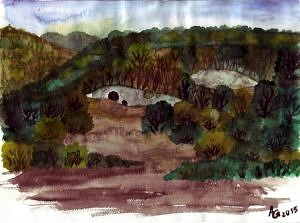
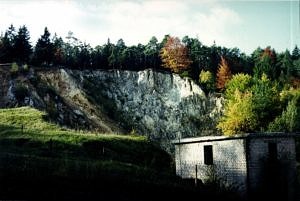
The “Steinberg-Höhlenruine” is located in a quarry of the company Sebald Zement GmbH on the eastern slope of the Steinberg above the small hamlet of Hunas, district of Pommelsbrunn (Nürnberger Land, Middle Franconia). It is located on private property and is no longer accessible.
Since work began in 1956, remains of over 140 animal species have been recovered. Besides mammals, birds, fish, amphibians, reptiles and molluscs are also represented. Among the most important finds include representatives of the primates: in 1986, the molar of a Neanderthal was recovered, as well as more than 30 remains of macaques spread over several years. The presence of the Neanderthal is also attested by numerous stone tools.
Team:
Contact:
Research History
- Discovery in 1956 by Prof. Dr. Florian Heller
- Excavation campaigns 1956-1964, 1983-2012
The site was discovered as early as 1956 by Prof. Dr. Florian Heller, Institute of Palaeontology, FAU Erlangen-Nuremberg. This was followed by a first excavation phase from 1956-1964 under the direction of Florian Heller. These 9 excavation campaigns were supported by the Institute of Palaeontology and the Institute of Prehistory and Early History of FAU Erlangen-Nuremberg as well as the quarry owner. The recovered archaeological and palaeontological finds were evaluated and published in a monograph in 1983. After a long break, work was resumed in 1983 because the cave space was acutely endangered by quarrying activities. Annual excavation campaigns of initially up to 6 months were carried out from 1983 to 2012. They were led by the Institutes of Palaeontology (Prof. Dr. J. Th. Groiß) and of Prehistory and Early History (Prof. Dr. L. Reisch) at FAU. In the early years, funds to finance the excavation campaigns could still be organised by the DFG and the district office, but in the 1990s the budget became so tight that a support association had to be founded in 1998 to finance the excavation mainly through donations. The quarry owner also covered a small part of the costs each year.
The excavation teams always consisted of experts from the FAU as well as students from Germany and abroad and committed laymen from the region. The excavation team was led by Dr. Wolfgang Weißmüller († 2005) in 1983, Brigitte Kaulich M.A. († 2006) from 1984 to 2006, and Dr. Brigitte Hilpert from 2006 to 2012.
Stratigraphy
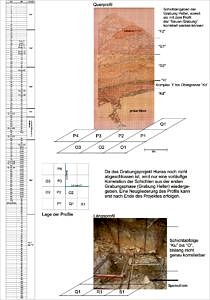
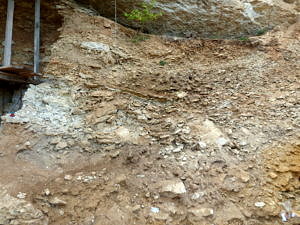
The former cave room is completely filled with sediments. The progressive degradation of the the rock roof and the cave walls, the entrance finally closed up. The cave was no longer recognisable as such. The full extent of the cave room and the location and size of the entrance are unknown, as parts of the cave were destroyed by quarry operations. Without the quarry, however, the cave would not have been discovered either.
About 12 m of the sediment fill have been investigated. The sequence shows a succession of differently composed sediments. The bulk of the sediment consists of dolomite sand as well as dolomite rubble of different sizes. The colour of the sediment varies between brown, grey and yellowish tones.
Ursidae
by: Dr. Brigitte Hilpert
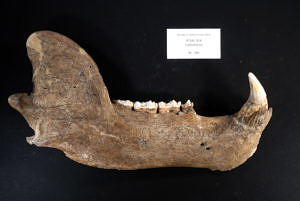
The results of the biological and taphonomic examinations of the skeletal elements of the bears from Hunas show that the den was mainly used as a hibernation and litter den. Most of the cubs died during their first hibernation. The few pathological findings indicate that some bears may have fallen victim to predators. The cave was used more by bears during the period of stratum D-F than during the period of strata G1-M (or O), at least the quantities found in D-F are much larger than in G1-M.
The metric analyses showed that the bear was a normal, average-sized cave bear. The structure of the occlusal surface of the teeth is more simply built than in most bears from comparably old Austrian sites, but resembles bears from Upper Pleistocene sites of the Franconian Alps. The morphological features of the rest of the skeleton largely correspond to those of Ursus spelaeus.
Besides the finds of Ursus spelaeus, some remains of Ursus arctos could be identified.
Hilpert, B. (2006): Die Ursiden aus Hunas – Revision und Neubearbeitung der Bärenfunde aus der Steinberg-Höhlenruine bei Hunas (Gde. Pommelsbrunn, Mittelfranken, Bayern). Internet-Publikation: URN: urn:nbn:de:bvb:29-opus-4123 URL: www.opus.ub.uni-erlangen.de/opus/volltexte/2006/412/
Fish, amphibians, reptiles
by: Dr. Gottfried Böhme, Museum für Naturkunde – Leibniz-Institut für Evolutions- und Biodiversitätsforschung an der Humboldt-Universität zu Berlin
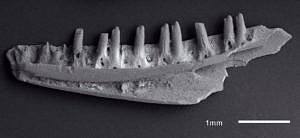
The ecological interpretation on the basis of amphibian and reptilian skeletal remains from recent excavations in the Pleistocene deposits of Hunas allows a more precise account of climatic developments during their sedimentation than was possible so far with the material excavated at the locality by Heller. The basic tendency of the climatic development (fluctuations from moderate to cool climate), as pointed out by Groiss in 1983, is confirmed. The results presented here clearly show an early to high glacial sequence, rather than a Late glacial sequence. Interglacial climate conditions are still
demonstrable at the base of the sequence, directly above the sinter crust.
Based on the detailed procedures of sampling and due to the thickness of the sections, it was possible for the first time on the basis of the preserved skeletal remains to follow the development of the fish- and herpetofauna over an extended period of an early glacial period. To some extent surprising results were obtained by comparison with our previous knowledge about the requirements and distribution of recent forms. This applies in particular to the duration of the occurrence of Anguis fragilis and Coronella austriaca during the early glacial. The herpetofauna became depleted during the early glacial under the influence of climatic conditions, a process which can gradually be traced on the example of the sequence at Hunas. Thus, better interpretations of climatic history possible with amphibian and reptile remains are also applicable for other find complexes.
The development of the herpetofauna in the central European upland zone now shows a more differentiated picture for the transition from early to high glacial climatic conditions, which can be characterised as follows:
The succession begins with an interglacial phase characterized by the presence of Elaphe longissima. Early glacial faunas follow with phase 1 including Triturus vulgaris, Bufo bufo, Rana arvalis, Rana temporaria, Anguis fragilis, Lacerta vivipara, Coronella austriaca and Vipera berus, and phase 2 including Rana temporaria, Anguis fragilis, Lacerta vivipara and Vipera berus. The high glaciation fauna contains exclusively Rana temporaria. No substantial change could be determined over the same period concerning the fish fauna, which is documented only to a relatively small extent for the sequence at Hunas. The species present are characteristic for the salmonid region of fluvial environments (Salmo trutta, Thymallus thymallus, Phoxinus phoxinus, Lota lota, Cottus gobio). Thus it is confirmed that the fish fauna from these river systems is only marginally affected by climatic changes.
Böhme, G. (2011): Fisch-, Amphibien- und Reptilienreste aus der Höhlenruine Hunas bei Hartmannshof (Mittelfranken). – Quartär, 58, 7-23.
Herpetofauna
Cooperation with Prof. Dr. Johannes Müller, Museum für Naturkunde, Leibniz-Institut für Evolutions- und Biodiversitätsforschung an der Humboldt-Universität zu Berlin.
Small mammals
Cooperation with Chris Baumann, University Tübingen, and Dr. Lutz Maul, Senckenberg Forschungsinstitut, Forschungsstation für Quartär-Paläontologie Weimar.
Baumann, C. (2011): Kleinsäugerfunde aus drei Profilsäulen (N2, Q1, S2) der mittel- bis spätpleistozänen Höhlenruine Hunas (Mittelfranken). Ein Beitrag zur biostratigraphischen und paläoökologischen Auswertung der Fundstelle. – Unpublizierte Bachelorarbeit, 71 S., Friedrich- Schiller- Universität Jena, Philosophische Fakultät, Ur- und Frühgeschichte.
Herbivora
by: Dr. Brigitte Hilpert
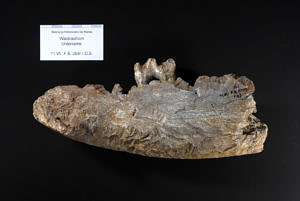
The finds from the families Cervidae, Bovidae, Suidae, Equidae and Rhinocerotidae offer the possibility to study interactions between predators and prey, as well as taphonomic processes in the cave and possible interactions between Neanderthals and hunting prey. These species can also be used for climatic reconstructions.
Carnivora (without Ursidae)
by: Dr. Dieta Ambros
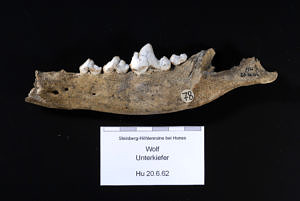
The finds from the families Canidae, Hyaenidae, Felidae and Mustelidae offer the possibility to investigate interactions between predators and prey. The focus is also on a more precise phylogenetic-temporal classification. The metrical deviations observed so far can probably be explained by the warmer conditions compared to most of the sites of comparison. For this purpose, a revision of Heller’s naming is planned, as he assumed a much earlier chronology.
Archaeology
Cooperation with Institute for Pre- and Protohistory, Department for Classical World an Asian Studies, Friedrich-Alexander-Universität Erlangen-Nürnberg (FAU) (Prof. Dr. Thorsten Uthmeier) and Dr. Aviad Agam ( LTFAPA Laboratory, Department of Science of Antiquities, Sapienza University of Rome, Italy)
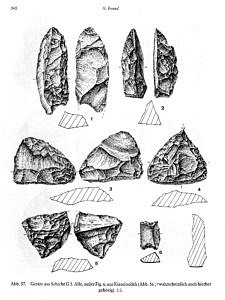
Stone tools are not only suitable as evidence of human presence or for stratigraphic purposes. They also allow further, interesting analyses. In cooperation with Dr. Aviad Agam, the question was pursued whether and in what way the Neanderthals used fire.
First results are submitted actually in:
Journal of Paleolithic Archaeology
Ambros, D., Hilpert, B., Kaulich, B., Reisch, L. & Rosendahl, W. (2005): Steinberg-Höhlenruine bei Hunas (HFA A 236). – in: Ambros, D., Gropp, C., Hilpert, B., Kaulich, B.: Neue Forschungen zum Höhlenbären in Europa, Abh. Naturhist. Gesell. Nürnberg, 45/2005, 325-342, 9 Abb., 1 Tab., Nürnberg.
Freund, G. (1983): Die paläolithischen Kulturreste aus der Höhlenruine von Hunas in der Nördlichen Frankenalb. – In: Heller, F. (Hrsg.): Die Höhlenruine Hunas bei Hartmannshof (Landkreis Nürnberger Land) – Eine paläontologische und urgeschichtliche Fundstelle aus dem Spät-Riß. – Quartär-Bibliothek, 4, 323-349, 1 Tab., 5 Abb., Bonn.
Speleotheme
Cooperation with Dr. J. Fietzke, GEOMAR Helmholtz-Zentrum für Ozeanforschung Kiel and Dipl.-Geol. Matthias Lopez-Correa, GeoZentrum Nordbayern, Lehrstuhl für Paläoumwelt.
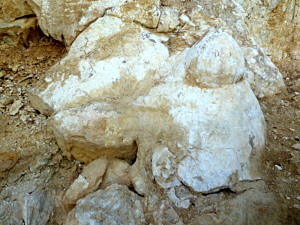
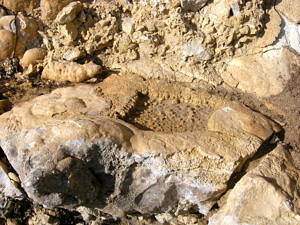
At the Hunas site, a diverse speleothem came to light under the cave sediments. Among other things, U/Th dating was carried out. Further analyses are in progress.
Literature (small selection):
HILPERT, B. & D. AMBROS (2021), Spurenlesen an 200.000 Jahre alten Knochen. Einblicke in die Lebenswelt der Steinberg-Höhlenruine von Hunas. Bayerische Archäologie 2/2021, 2021, 18–21.
HILPERT, B. & D. AMBROS (2015), Jäger und Gejagte – Die Geschichte der Fundstelle Hunas. Ein Führer zur Steinberg-Höhlenruine bei Hunas (Büchenbach 2015).
C. Baumann (2011): Kleinsäugerfunde aus drei Profilsäulen (N2, Q1, S2) der mittel- bis spätpleistozänen Höhlenruine Hunas (Mittelfranken). Ein Beitrag zur biostratigraphischen und paläoökologischen Auswertung der Fundstelle. Unpublizierte Bachelorarbeit, Friedrich-Schiller-Universität Jena, Philosophische Fakultät, Ur- und Frühgeschichte (Jena 2011).
Wilfried Rosendahl, Dieta Ambros, Brigitte Hilpert, Ulrich Hambach, Kurt W. Alt, Maria Knipping, Ludwig Reisch, Brigitte Kaulich (†) (2011): Nenderthals und Monkeys in the Würmian of Central Europe: The Middle Paleolithic Site of Hunas, Southern Germany. – N.J. Conard and J. Richter (eds.), Neanderthal Lifeways, Subsistence and Technology: One Hundred Fifty Years of Neanderthal Study, Vertebrate Paleobiology and Paleoanthropology, DOI 10.1007/978-94-007-0415-2_3, © Springer Science+Business Media B.V. 2011.
BÖHME, Gottfried (2011): Fisch-, Amphibien- und Reptilienreste aus der Höhlenruine Hunas bei Hartmannshof (Mittelfranken). – Quartär, 58, 7-23.
HELLER, F. (Hrsg.) (1983): Die Höhlenruine Hunas bei Hartmannshof (Landkreis Nürnberger Land) – Eine paläontologische und urgeschichtliche Fundstelle aus dem Spät-Riß. – Quartär-Bibliothek, 4, 407 S., Taf. I-XII, 62 Abb., 49 Tab., Bonn.
